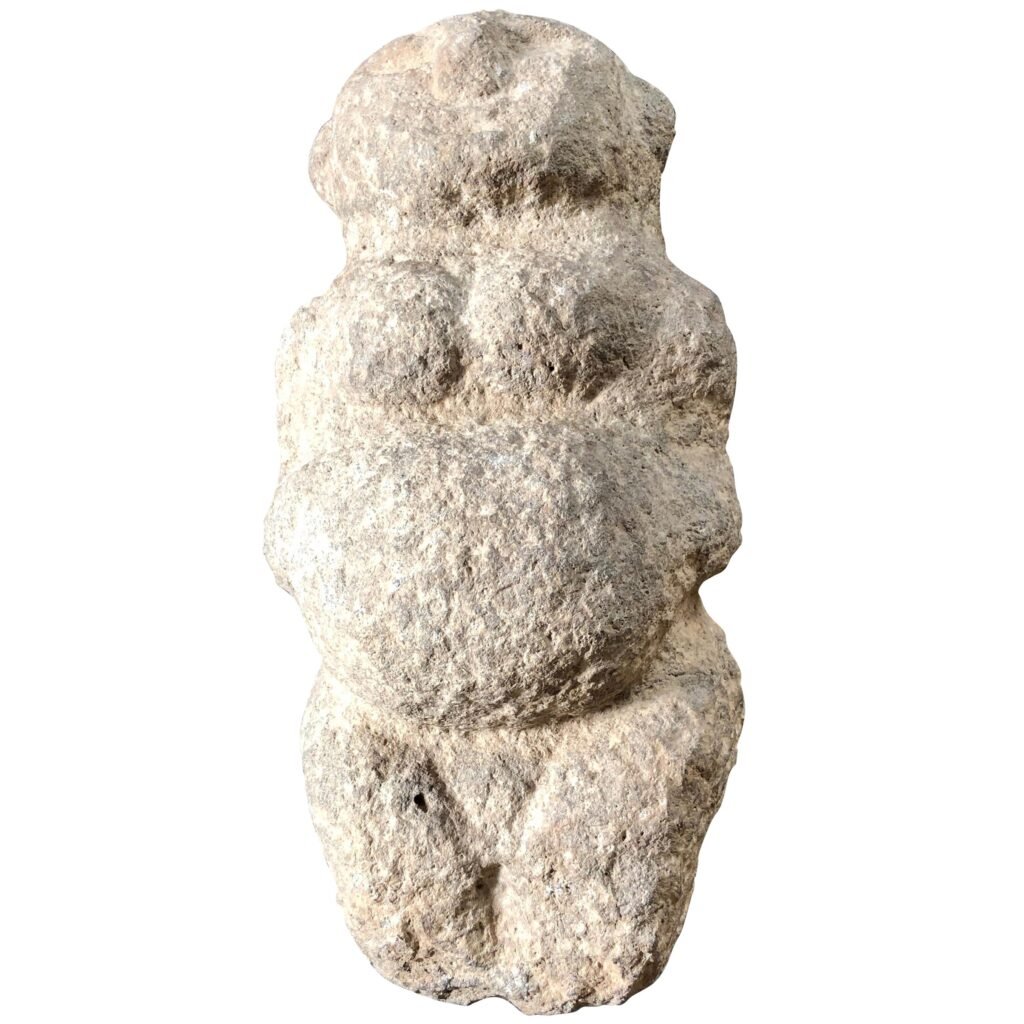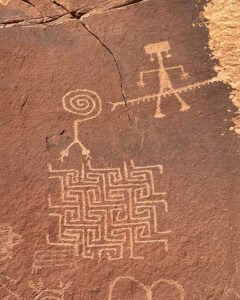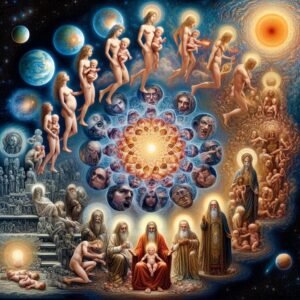
YangShao Culture Neolithic Amphora Vase – 3000 BC
Understanding of the divine nature of the hiding of the divine feminine in history
This article discusses the possibility that the observed transition from a feminine dominated understanding of divinity to a masculine dominated one may be a natural part of a cycle of creation.
The idea of a cyclical nature to the balance between the masculine and the feminine
There’s a number of belief systems that propose, or infer, a cyclical nature to the universe. Let us look at this exchange of power and visibility between the divine feminine and masculine as being just that. That there is a cycle where the balance of power, between the masculine, and the feminine, is constantly changing, testing every possible balance point.
This can probably best be visualised as a syne wave, as this is also the full circle, 360 degrees, every angle is considered. The universe testing all balance points in that divine exchange of energy and thought.
Seeing a balance through all 360 degrees
I also propose that this divine demand for an ever changing balance point will not be seen as a pure syne wave when we try to see the impact of these energies on humanity. Instead, I propose that, as any reaction in the human world, is not immediate, and we can visualise the effect of that lag, as the shape of the Ying-Yang symbol, and understand that this is also a waveform, if we see it as rotating through 360 degrees.
the concept is that the energy going into the creation is a perfect syne-wave. However, as we know, organic structures often need to build momentum and tend to lag the energetic input. We can see, therefore, that this lag effect, does indeed affect the immediate outcome in human relations.
When the “divine powers”, for example, choose that a new balance means a new country must be invaded, let us say, then the people must first be rallied, and persuaded there is benefit to an invasion. Then the army itself must be raised, and the enemy provoked, and only when this war is over, even with divine help and a natural balance in their favour, that could be quite some time lag.
Where are we in this cycle?
If we look at those previous discussions, we could propose that we have passed through most of the feminine authority stage of the cycle, the first half wave, and that we can assume that we are therefore in the masculine part of that wave. Are we able to propose where we are then? in the middle, or closer to the end?
Has the balance started to shift back to the feminine?
The Yin-Yang Symbol as a Cyclical Framework
The yin-yang symbol represents a dynamic balance between opposites—light and dark, feminine and masculine, active and receptive. Key features of the symbol that are relevant to this proposition include:
Interdependence: Each force (yin or yang) contains a seed of its opposite (represented by the small dot within each half), suggesting that even at the peak of one energy’s dominance, the other begins to reassert itself.
- Flow and Transition: The curved boundary implies that the dominance of one force is never abrupt but transitions smoothly over time, reflecting the gradual ebb and flow of influence.
- Balance over Time: The cycle is not about permanent dominance but a constant search for equilibrium, with each force having its turn to rise and recede.
Application to the Divine Feminine and Masculine Cycle
The Feminine Half-Wave (First Phase)
Historically, artifacts like mother goddess figurines, myths centred on creation and fertility, and matriarchal or goddess-centric spiritual systems suggest that societies once deeply revered the divine feminine. This phase could correspond to the ascending feminine part of the wave, where balance tipped toward nurturing, creation, and interconnectedness.
The Masculine Half-Wave (Second Phase)
With the rise of patriarchal societies and male-dominated spiritual systems, we might place ourselves within the descending feminine/ascending masculine part of the wave. The dominance of hierarchical structures, emphasis on conquest, and suppression of the feminine could reflect this phase.
Current Moment in the Cycle
If we are in the masculine phase, the critical question is whether we are nearing its peak (maximum yang) or witnessing the transition back to feminine dominance (emergence of yin).
Indicators of a shift might include:
- Cultural Trends: The resurgence of feminist movements, increasing recognition of feminine values like collaboration and empathy, and a renewed interest in nature-based spirituality.
- Challenges to Patriarchy: The questioning of rigid hierarchies, male-dominated power structures, and the suppression of feminine voices in religion and politics.
Insights from the Yin-Yang Symbol
Seeds of Opposite Energy
The small yin (feminine) dot in the yang (masculine) half suggests that even at the height of masculine dominance, feminine energies are present and beginning to grow. This aligns with the rise of movements that seek balance and equality.
Similarly, the yang dot in the yin half reminds us that masculine traits such as action, assertiveness, and structure are necessary even in a feminine-dominant phase.
Dynamic, Not Linear
The yin-yang rotation implies that cycles are dynamic and do not move in a strict linear progression. Instead, they spiral, suggesting that while patterns repeat, they do so in evolving contexts.
Moral implications of a masculine/feminine power sharing cycle
This line of thinking opens us up to profound moral and philosophical implications. If we consider the cyclical exchange between the divine feminine and masculine as part of a “natural divine order,” then what may appear as suppression or dominance could also be seen as the fulfilment of a cosmic rhythm. Let’s delve into this concept, examining both the moral nuances and the potential suppression of deeper truths by those in power.
The Divine Cycle as Moral Neutrality
A Balanced Cosmic Order
If the divine masculine and feminine alternate in prominence as part of a natural cycle, then neither dominance nor suppression would inherently be “good” or “bad.” Instead, these shifts serve to explore the full spectrum of divine energy, providing humanity with a variety of experiences and lessons.
This perspective challenges the moral framing of suppression or ascension. Actions taken to establish or defend dominance—whether by the feminine or masculine—might be viewed as necessary to maintain the cosmic rhythm.
Complexity of Moral Judgment
From this lens, labelling the suppression of the divine feminine (or masculine) as inherently immoral becomes difficult. What seems like suppression may instead be the ebbing of one energy to make way for the flow of another.
However, this neutrality depends on an overarching belief in the benevolence of the cosmic order. Without this, cycles may appear as arbitrary or unjust.
Moral Implications of Suppression
Natural vs. Artificial Suppression
If shifts in divine prominence are part of a natural order, the question arises: when does suppression cross the line from natural progression to artificial interference?
Example: A king taking his rightful place as a deity following the queen could align with divine order.
But systematic erasure (e.g., rewriting texts, burning sacred artifacts, or vilifying feminine figures) may suggest human manipulation rather than cosmic will.
This distinction raises the moral question of agency: are humans justified in acting as enforcers of divine will, or should they allow shifts to occur organically?
The Role of Knowledge Keepers
If those “close enough to know” suppress information about this divine cycle, their motives matter greatly.
Were they acting to protect the natural order from misunderstanding? Or were they consolidating power by exploiting cosmic rhythms for personal or political gain?
Example: The Roman Catholic Church’s suppression of Mary Magdalene’s Gospel may have been an act of political consolidation, but what if it was seen as necessary to maintain societal stability during a masculine-dominated era?
Gender, Power, and Moral Responsibility
The King’s Turn as Prime Deity
If the king’s rise after the queen represents a rightful place in the cycle, then efforts to suppress feminine authority could reflect the divine masculine’s ascendance rather than outright denial of the feminine.
This complicates our understanding of morality: is it wrong to diminish one energy if doing so allows the other to flourish as intended?
However, moral responsibility arises in ensuring that the rise of one does not annihilate the other but allows it to retreat into balance.
Suppression as a Test
Suppression may serve as a divine test. The diminished energy might remain visible in hidden forms, waiting for recognition and restoration by those attuned to its presence.
Moral growth could emerge from humanity’s struggle to rediscover and reintegrate suppressed aspects of the divine.
Yin-Yang Revisited: The Queen and King as Equals
Divine Dance, Not Supremacy
The yin-yang symbol offers a corrective lens: the queen and king are not rivals but partners, their energies blending and cycling to sustain universal harmony.
Suppression of one diminishes the whole, as the energy of the dominant principle relies on the retreating energy for renewal.
Reclaiming the Feminine
The resurgence of feminist movements and spiritual reawakening toward the divine feminine could signal the natural return of balance.
Morally, the challenge lies in avoiding revenge or retribution for past suppression and instead embracing the wholeness of the cycle.
Morality in Cycles
These moral nuances of divine cycles challenge simplistic views of dominance and suppression. If shifts in power are natural, then suppression or resistance to that cycle may only lead to suffering and pain. Perhaps the knowledge that the queen is always destined to return to dominance mean she is happy to remain hidden during the time of the king?
However, human interference complicates this dynamic, raising questions about agency, power, and responsibility. The moral imperative seems to lie in recognizing the interplay of energies and acting in ways that honour the cyclical nature of creation rather than distorting it for temporal gain.
Where in the cycle are we at?
I’d suggest, contrary to many claims, that, in England, the peak of power for the divine masculine has occurred. It peaked in the 1950’s and beyond. If we look at events and decisions regarding women, it is very clear to see that the divine feminine, and the acceptance of feminine power and autonomy has seen quite a dramatic turnaround from those times:
- Catholic Church Reforms: The acknowledgment of Mary Magdalene’s true role in 1969 may have been symbolic of deeper, albeit slow, changes within religious institutions. Pope Francis, for instance, has expressed openness to reconsidering women’s roles in the Church.
- Women in Leadership: Across fields, the rise of female leaders—from politics (Margaret Thatcher in the 1970s, Jacinda Ardern in the 21st century) to corporate boardrooms—signals systemic change.
- Media and Representation: Popular media increasingly champions strong, independent female protagonists, celebrating empowerment and dismantling old stereotypes.
- Fashion and Expression: Women’s fashion has become a medium for self-expression and liberation, far removed from restrictive historical norms.
- Legal parity with Men: Many women now have the legal and financial autonomy once denied them, with significant strides made in the 20th century (e.g., property ownership rights, the Equal Pay Act).
- Feminist “waves” throughout the 20th and 21st centuries, from suffrage to #MeToo, have challenged deeply entrenched patriarchal norms.
- Grassroots organizations advocating for intersectional feminism show a growing embrace of holistic and inclusive feminine energy.
We know the current situation is not perfect, but the signs are all there, are they not? We must be well over the peak of masculine dominance, and if the Yin-yang symbolic model is correct, then we should expect the current rate of change to increase quite dramatically.
We can see this today with:
- Environmental Advocacy: Feminine principles of nurturing and sustainability are driving global movements to combat climate change and ecological degradation.
- Redefinition of Masculinity: Modern conversations around “toxic masculinity” and emotional openness among men reflect a softening of rigid gender norms and a reconnection with balanced energies.
- Spiritual Resurgence: Ancient goddess traditions and feminine spirituality are seeing a revival, particularly in New Age and Pagan circles.
Cycles in myth and belief
The idea that humanity is entering the Age of Aquarius, for example, is one of many cyclical beliefs about time and transformation. While the specifics differ across cultures and traditions, many belief systems propose an endpoint or a transformational shift in the current era. Below, we explore these beliefs and their potential intersections with eschatological or “end of the world” scenarios.
The Age of Aquarius (Astrological Cycle)
Overview: The concept comes from Western astrology, where the earth’s precession through the zodiac constellations marks roughly 2,150-year epochs, known as astrological ages.
Significance: The Age of Aquarius is often associated with enlightenment, humanitarianism, technological progress, and spiritual awakening. It’s seen as a time of breaking down old systems (Age of Pisces values like centralized authority and religion) and fostering collective growth.
Impact: This transition is believed to inspire shifts in global consciousness, which may already be visible in movements for equality, environmental protection, and decentralized governance.
The Kali Yuga (Hindu Cycles of Time)
Overview: Hindu cosmology divides time into four Yugas (ages), with Kali Yuga being the last and darkest age. This is marked by moral decay, spiritual disconnection, and societal strife.
Where We Are: According to traditional interpretations, we are currently in Kali Yuga, and some say we are nearing its conclusion. The end of Kali Yuga would herald a pralaya (destruction) followed by a new cycle starting with Satya Yuga (the age of truth and righteousness).
Signs of Transition: Increased societal unrest, environmental degradation, and a collective yearning for spiritual renewal may align with the characteristics of the Kali Yuga’s end.
The Mayan Calendar and 2012
Overview: The Mayan Long Count calendar ended a major cycle on December 21, 2012, leading to widespread speculation about an apocalyptic or transformative event.
Reality: While the world didn’t “end,” many interpret this as a symbolic end of one world cycle and the beginning of another. It aligns with themes of spiritual awakening, environmental stewardship, and new global paradigms.
Ragnarok (Norse Mythology)
Overview: Norse myths describe Ragnarok, the final battle where gods and forces of chaos clash, leading to the destruction and eventual rebirth of the world.
Themes: The idea of a world-ending conflict followed by renewal resonates with other beliefs about cyclical time. Some interpret Ragnarok allegorically, as a warning about human hubris or ecological collapse.
Abrahamic Eschatology (Judaism, Christianity, Islam)
Judaism: Jewish eschatology anticipates the coming of the Messiah and the establishment of an era of peace.
Christianity: Many Christian traditions foresee the Apocalypse, Second Coming of Christ, and a final battle between good and evil (Armageddon).
Islam: Islamic eschatology describes Qiyamah (the Day of Judgment), involving the return of Jesus (Isa), the defeat of the Antichrist (Dajjal), and the ultimate triumph of divine justice.
Current Relevance: These beliefs often interpret societal upheavals, wars, and natural disasters as signs of the end times.
Hopi Prophecies (Indigenous North America)
Overview: The Hopi people envision a time of great purification, where humanity faces a choice to live harmoniously with nature or face destruction.
Prophetic Markers: Many interpret environmental crises, technological advancements, and cultural fragmentation as signs that we are approaching the “Fifth World,” a new age of harmony.
Theosophy and Blavatsky’s Root Races
Overview: Theosophical teachings by Helena Blavatsky describe humanity evolving through Root Races, with the current (fifth) Aryan race giving way to the sixth, which is expected to usher in heightened spiritual awareness.
Timing: Theosophy doesn’t specify precise dates but aligns with the broader idea of transformative periods.
Buddhist Maitreya and the Decline of Dharma
Overview: Buddhism predicts that the teachings of the Buddha (Dharma) will decline until a new Buddha, Maitreya, arises to renew the spiritual path.
Context: Signs of spiritual degradation, materialism, and disconnection are seen as precursors to this renewal.
Zoroastrian Saoshyant
Overview: Zoroastrianism predicts the coming of Saoshyant, a saviour figure, who will lead the world into a final confrontation with evil, followed by universal resurrection and purification.
Implications
Understanding that many religions and beliefs see the universe as a set of repeating, yet changing cycles. Together with the knowledge that their has indeed been a shift from the feminine, to the masculine. Could help us understand, anticipate and accept that such shifts in the balance of power may be natural, and that resistance may well be futile. The difficulty, of course, is seeing things that way at the time of any challenge to our perceived status quo. I’d suggest these cycles challenges us to:
- Accept Change: Recognize that chaos and renewal are natural processes.
- Act Responsibly: While cycles may be inevitable, human actions can either exacerbate or alleviate suffering during transitions.
- Seek Balance: Integrating masculine and feminine energies, spirituality and materialism, and individual and collective needs may help smooth these transitions.
Subscribe to our post updates - Don't miss a thing!!







